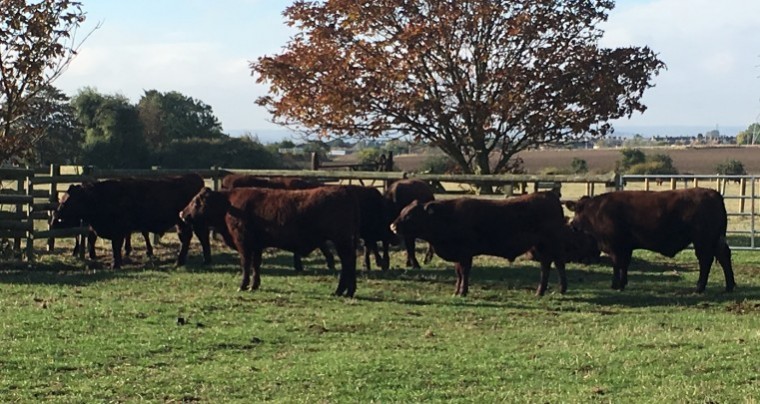The Holm Place cattle have been performance recorded for over 20 years and estimated breeding values (EBVs) are used as a management tool to guide breeding decisions. John and Cathie are keen to progress the genetic developments, with high beef values and high maternal figures as standard in the herd. Conformation is also an important aspect and they use ultrasound to measure muscle and backfat to monitor development.
John said: “Breeding better cattle has long been the prime motivation of the herd policy and the only objective way of assessing cattle is to measure.”
Recent bulls used include Boxted Endeavour and Holmplace Wellington V. Both are in the top ten per cent of the breed for Beef Value and Maternal Production Value.
Calves born in 2016 were sired by Endeavour and Boxted Polled Duke. The spring-calving Boxted herd are bred locally by the Stevens family and they have shared homebred bulls between the herds for years. The Holm Place herd calves in autumn so bulls provide good value, working two seasons each year.
John Lewis said: “There has been a resurgence of the Sussex breed in recent times due to its easy calving attributes. The Sussex suits the modern market well, producing carcases that are not too big.”
Females have a performance history above average for the breed. All Holm Place bulls sold for breeding are guaranteed to be within the top ten per cent for Beef Value.
Case study
The Holm Place herd, owned by John and Cathie Lewis from the Isle of Sheppey in Kent, has been recognised by AHDB Beef & Lamb as the Most Improved Herd of Sussex cattle in England for 2016.
The award is presented by the AHDB Beef & Lamb Better Returns Programme (BRP) to the recorded herd that shows the greatest genetic gain for commercial characteristics over a 12-month period. There is a separate award for each of ten UK breeds.
The Holm Place herd was established in 1971 with the purchase of four mature, unregistered in-calf cows who were inspected for registration when the herd book was opened. Their first bull, Chelsfield Keystone, was purchased in the spring of 1972 and remained in the herd for seven years, serving their Hereford x Friesian cows as well as the Sussex herd.
Over the years, John realised that the crossbred cows were less economical, needing supplementary feeding when the Sussex did not. Consequently from 1976, the objective changed from store production to quality breeding stock and the crossbred cows were phased out.
At this time they moved from spring calving to August/September calving for ease of management and to work in harmony with the seasons. The Sussex is a hardy, thrifty breed that are effective convertors on a low-input, permanent-pasture systems. Out-wintered, they graze the marshes year-round, producing an efficient output.
Mr Lewis has recorded the Holm Place cattle for over 20 years and estimated breeding values (EBVs) are used as a management tool to guide breeding decisions and progress the genetic developments within the herd. The herd boasts high beef values and high maternal figures as standard.
In 1997 they began showing cattle as a practice run for the British held World Congress. Holm Place Premier 1st was shown the following year as a yearling bull at the Congress and from there enjoyed many years attending their local Kent Show. In his era, his performance figures put him in the top ten per cent for the breed.
Another homebred bull, Holm Place Major, born August 1997, had a modest appearance but outstanding performance. He was sponsored by MLC and his genetics were widely used in the breed.
“Breeding better cattle has long been the prime motivation of the herd policy and the only objective way of assessing cattle is to measure,” said Mr Lewis.
“Being paid pence per kilo, the quicker cattle put on the kilos, the sooner we can cash them in!”
Conformation is another important aspect and for many years, eye muscle and back fat have been measured using ultrasound. As figures are collected over the years they become more useful. The data analysis fee is subsidised by levy (AHDB Beef & Lamb) and with further support through the Breed Society discounts, recording remains extremely good value.
More recently the bulls used include Boxted Endeavour and Holmplace Wellington 5th. Both are in the top 10% for Beef Value and Maternal Production Value.
Calves born in 2016 were sired by Endeavour who was used for a second season and Boxted Polled Duke. The Boxted herd are bred locally by the Stevens family who have worked closely with John and Cathie for years, often sharing homebred bulls between the herds and sometimes joining to purchase a new bull. As the Boxted herd calve in spring, this arrangement works well and provides good value with bulls working two seasons each year.
The Holm Place herd is a closed herd, except for the occasional purchase of new bulls and the herd has an elite health status.
Purchasers of heifers have peace of mind knowing they are investing in females with performance history above average for the breed. All Holm Place bulls sold for breeding are guaranteed to be within the top ten per cent for Beef Value.
Commenting on sales, Mr Lewis said “There has been a resurgence with the Sussex breed in recent times as producers like the easy calving attributes of the breed, calves are born small and grow like smoke! We don’t want carcases to become too big, so the Sussex breed suits the modern market well.”




